skip to main |
skip to sidebar

An Attitude of Gratitude...
Happy Thanksgiving from everyone here at Technifold USA!
"Gratefulness is the key to a happy life that we hold in our hands,
because if we are not grateful, then no matter how much we have
we will not be happy -- because we will always want to have
something else or something more." Brother David Steindl-Rast
We'll be CLOSED for the holiday
Thursday Nov 26th and Friday Nov 27th
******************************************************
How to Trim Problem Paper
In the perfect world, every sheet of paper is perfectly square
and each sheet is the same as the next. In our world, we
know this to be perhaps the exception. Maybe the paper
wasn't stored right, maybe it distorted after printing,
maybe it's a deckle edge sheet, the converter did a
lousy job...etc.
Whatever the reason, sometimes you're faced with having
to trim a job where sheet-to-sheet register seems
impossible when guillotine cutting. The recommended
solution is to obviously trim the stock before printing.
Sometimes this is just not possible...you've just got to
print the full sheet as it is.
Aside from die-cutting the piece, there is a way to
deal with this. Andrew Brennan of Delaware submitted this
tip and I've used a variation on this myself. A warning from
Andrew and me: use extreme care and if your paper
cutter manufacturer does not recommend doing this,
or they have an alternative solution, and by all means
follow their suggestions to avoid personal or machine
damage and inury! Common sense should prevail.
First: Construct or buy a hardwood wedge and insert it
in the cutter backgauge at the exact point
where the side guide would have pulled the sheet.
(image below)
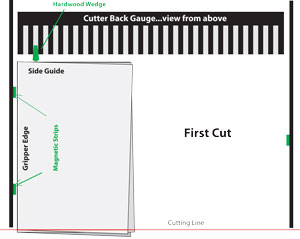
Place magnetic strips on the cutter side at points
where the grippers would have grabbed the sheet.
Be sure both the wedge and the strips go
completely to the bottom of the cutter table so
sheets don't slide underneath, and you don't want
them to ride above either. Then make your first cut.
Next, rotate the stock as shown below to cut away
the tail of the sheet opposite the gripper.
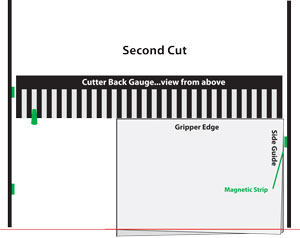
Now you have two square edges to work with.
Depending on the job, you might carefully finish the cutting
while leaving all the objects in OR you might do
these first two cuts, set the lifts aside and do the
final trimming in a second pass. In either case,
don't forget to remove all objects before continuing
on to the next job.
This technique works surprisingly well, but let's hope
you don't have to pull it out of the hat too often!
******************************************************
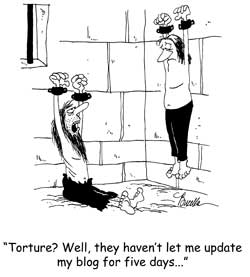
******************************************************
Point of View
A thankful heart is not only the greatest virtue,
but the parent of all other virtues.
Cicero
What we're really talking about is a wonderful day set aside
on the fourth Thursday of November when no one diets.
I mean, why else would they call it Thanksgiving?
Erma Bombeck
Another No-Cost Business Tool from Google
The new Google Voice product gathers all your calls from your
various phones, which can then be accessed from your home,
office or cell phone.
If you ignore a voice mail, it is transcribed and sent to you as
an e-mail. And Voice lets you make free conference calls and
cheap international calls. To get started with the service,
you set up a personal Voice Web page, where you link your
home, work and cell numbers with a new number given to
you by Voice.
The new number link is used because Voice is still somewhat
under development. Before long, they will have number
portability so you won't have to use the number link they
give you to start. When one of the designated phones rings,
you can pick up whichever phone is most convenient.
You can press * to make all the phones ring again. Voice
does a pretty good job of recognizing words in a
voice mail and transcribing them. Depending on the
clarity of the speaker's diction, it could get a word or two
wrong, but generally the meaning of the message is
not changed.
You can sign up for the service at google.com/voice.
Right now, there is a waiting list.
******************************************************

******************************************************
Point of View
A mind troubled by doubt cannot focus on the course to victory.
Arthur Golden
A great marriage is not when the perfect couple comes together.
It is when an imperfect couple learns to enjoy their differences.
Dave Meurer
******************************************************
Need to Segregate Digital Work from Offset?
Or do you simply need to streamline your digital operation?
Check out the Speedcreaser here.
 It's a low-cost creasing and/or
It's a low-cost creasing and/or
micro perforating solution
specifically designed for
the short-run department
or copy shop.
Currently we have customers using these in all
sorts of normal digital applications--flyers, brochures,
book covers as well as the unusual such as
creasing boxes and wrappers for promotional products.
The Speedcreaser can also be run inline with right
angle sections from folding machines, turning unused
or little-used items into productive pieces.
The Auto Feed version can also be used as a
feeder for various equipment.
Call Mark at 401-364-3735 or contact us with your questions.
******************************************************
George Foreman Hands a Knockout to Andre
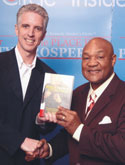 "Why did you name all your sons George?"
"Why did you name all your sons George?"
is one of the most-asked questions put
to this boxing and business champ (and no,
I did NOT ask him and no, I'm not that
tall...he is sitting in the photo at left,
handing me a copy of
his latest book
Knockout Entrepreneur.)
His exchange with the reporter
went something as follows:
"Do you know Ali?"
Yes.
"Do you know Holyfield?"
Yes.
"Do you know Joe Frazier and Ken Norton?"
Yes.
"Well, let all those guys hit YOU in the head and see how
many names you can remember!"
In his book, Foreman says one of the biggest obstacles to
success is fear of taking a risk and the desire to stay in your
comfort zone. While making his comeback, he found his right
hand had weakened. Normally a boxer moves in tight circles
to the left as he moves around the ring. Foreman decided to
work on moving to the right, and worked twice as hard
on his left hand.
Challengers in the ring who had studied his old films (where
he moved to the left) were surprised when they found a
strong left-handed George moving to the right. He credits
that change in fundamentals with taking him back to the top.
He took a weakness and turned it into an opportunity.
"There's no shame in changing," says Foreman. His advice:
ask probing questions..."How can I do what I do better...
am I problem oriented or solution oriented?"
Hmmm...I think he's been reading our newsletters!
If you ever get the chance to hear big George speak, do it.
He's the real deal...an authentic, engaging, funny and
inspirational man driven by his faith, family and community.
******************************************************
Fold Roller Washes
A reader asked our opinion on using MRC (metering roller cleaner)
for folding machine fold rollers. Mark did a little research on the
topic, and here's what we found.
Most of us are inclined to lump all combination style fold rollers
into one rubber+steel category. But rubber is a very broad
category and in fact there are many types of vulcanized
rubber, polyurethanes and foams that are used in fold rollers,
even within the same makes and models.
So MRC, a 'rubber' roller cleaner, should be OK to use, right?
Not so fast. The rubber used in metering rollers is different
than fold roller rubber, and using MRC can damage your
fold rollers.
The first, best course of action is to check with the
manufacturer of your folder. Technology and materials
are changing all the time and you don't want to
inadvertently damage thousands of dollars of rollers.
"We've always done it that way" can be an expensive
motto, so double check whether that press wash or MRC
is compatible with your fold roller rubber.
MBO and Horizon techs recommend using Varn VWM, which
will remove both solvent-soluble and water-soluble glazes
in one washup. You'll get both types of build-up on
fold rollers, so it's convenient to have a one-step wash.
VWM can be mixed with 20 to 50% water for best results.
A Baum technician suggests using Surewash from RBP
Chemical on their fold rollers. Wayne Pagel of Kepes,
a specialist in fold rollers, cautions us to avoid rubber roller
(MRC) or type wash, and stick with a cleaner designed for
the type of rubber in your fold rollers.
As we discussed last week, running tough jobs like
aqueous will highlight worn or dirty fold rollers and you'll
want to clean more frequently when running tough jobs.
Just be sure to clean them with the right solution.
******************************************************

******************************************************
Point of View
Whatever you are ready for is ready for you.
Mark Victor Hansen
The real voyage of discovery consists not in seeing
new landscapes, but in having new eyes.
Marcel Proust
******************************************************
Web Press Headaches?
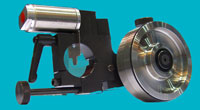 Is scoring on your web presses
Is scoring on your web presses
giving you fits?
Want to eliminate a separate,
offline scoring operation?
Then give Mark a call at
401-364-3735 or email
Mark@technifoldusa.com
The Web Creaser uses our Tri-Creaser technology,
adapted for web press speeds and installation requirements.
We can quickly outfit any web press.
'I Hate People'...
Though co-workers can be wonderful, you could be thinking
that some of them are a pain in the neck.
Like 'em or not, they're here to stay. You might as well
decide how they can help you or how you can avoid being
distracted by them. So say business writers Jonathan Littman
and Marc Hershon in their often-humorous book, which is
about dealing with various types in order to "get what
you want out of your job." So far, their I Hate People ...
has gained great reviews.
They do make a point when they say the person who has your
best interests at heart is probably the one sitting in your own chair.They recommend "solocrafting," which means moving forward with your work under any conditions.
What they advise:
Stop talking. Start doing. Stop asking (for whatever). And,
make them (the supervisors and co-workers) believe in you.
In other words, the writers of this humorous book are champions
of the entrepreneurial spirit in day-to-day shop or office life.
They also say teams with more than three to five competent
people are not very effective and can stifle your creativity.
Whether or not that's the case, the authors admit they don't
have all the answers.
You might find the book controversial, but at least it will
get you thinking.
******************************************************

******************************************************
Point of View
If your ship doesn't come in, swim out to it.
~ Jonathan Winters
One of the best ways to persuade others is with your ears,
by listening to them.
~ Dean Rusk
******************************************************
Folding Aqueous Coated Jobs...Feedback Part 2
Last week we touched on a few emergency techniques.
This week: equipment and environment.
Equipment
Working with aqueous or any challenging stock will tend to
highlight any flaws or worn items on your folder. For example,
a feed table register belt gets worn and glazed over time.
Normally it might not pose a problem, but present it with a
very slick stock and the problem appears. Often it's a
simple matter of cleaning, (be careful with the chemicals
you use!) or it may be time to replace (see last weeks
suggestions.) You may also find that the side guide and
register marble combinations may need to be
finessed with a slick stock.
Your fold rollers may be working just fine...until that aqueous job.
Again, more frequent cleaning with recommended roller wash
may do the trick (more on roller washes next week.)
MBO and Stahl both make use of an "open cell" foam
as a high-grip alternative to traditional polyurethane or
urethane and steel combo rollers. The downside is that the
rollers wear faster. Kepes, a manufacturer of post-press
specialty items and replacement parts, has taken the
foam roller one step further.
Their High Density fold roller has a simple design twist
 on the standard combo
on the standard combo
fold roller. It can use
either foam or urethane,
and has the added
advantage of
decreased
marking problems--there is no steel-to-steel overlap to
cause marking as the rubber wears down. (image above)
With a high-density design for extra grip, plus urethane for
longer life (compared to foam) you now have a good,
high performance upgrade that will help with tough stock.
Questions on the fold roller issue? Give Mark a
call at 401-364-3735 or email info@technifoldusa.com
and we'll point you in the right direction.
Environment
There have plenty of books and studies done on the
Pressroom environment; suffice it to say that
humidity and temperature differences play a vital role
in the successful printing and finishing of any stock.
A few readers wrote to say that they use humidifiers
and/or vaporizers to control the relative humidity in
the vicinity of the folder. Some swear by the use
fabric softener in the mister to help with the register.
But let's back up a bit. Paper is hygroscopic: it will either
take up moisture or release moisture into the environment
to reach the same state of humidity as the surroundings.
When it stops releasing or absorbing moisture, it is
at equilibrium. For best printing (and subsequent
finishing) results, paper should be at this state of
equilibrium before printing. Also, the paper should
be at the same temperature as the pressroom.
Sounds easy, right? Well, relative humidity changes with
the air temperature. Warm air holds more moisture than cool air.
A 70 degree room will hold more moisture than a 55 degree room,
hence the term "relative humidity." In the US, relative humidity
(RH for short) can vary form 10-90% depending on
location and time of year.
To add to the mix: humidity and moisture content
where the paper is manufactured make a difference in
how the paper will perform. Sooo...to simplify things,
most paper companies manufacture so that the end
user (the printer) gets best result at an RH of about
40 to 50%. Got all that?
If you haven't already done so, a study of your
press and bindery environment is a good place to
start. If no standards and controls exist,
a changing environment will make it harder to
troubleshoot any other items. For instance, say
your RH is 25% one day and 45% the next. How
will that affect job print quality, aqueous coating
and drying? A job that runs perfectly one day may be
totally different and mis-register the next. The operator
ends up fighting a "folder" problem that is really a
relative humidity problem resulting from variations in
drying, tackiness, curl, etc.
It's a complex subject. Avoiding it will cost you
tens of thousands of dollars over the years, not
to mention endless aggravation. Paper manufacturers are a
good place to start, and there are usually very specific
recommendations for preparing various papers for
printing.
Although no single source will give you all the answers
you need, (unless you get very lucky,) by instituting
standards, you chip away at the seemingly endless variables
that can affect your production.
Next week...manufacturer recommended solutions for
cleaning fold rollers.
******************************************************



